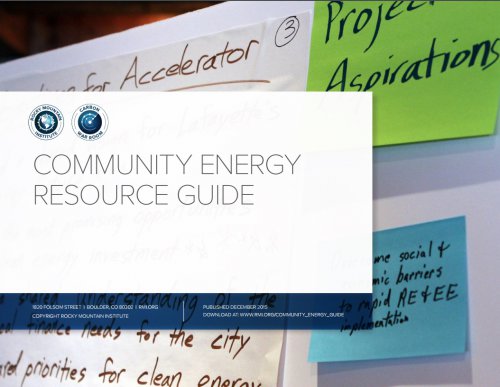Communities are at the forefront of the energy transition: citizens are increasingly asking their cities to develop and act on ambitious plans, and community leaders are seeing the social, political, and economic benefits of doing so. Even so, no standard roadmap or methodology exists to help communities transform their energy use. The purpose of this resource guide is to be that roadmap, and provide that methodology.
This guide is meant to help those U.S. communities with a desire to create a comprehensive energy action plan that will accelerate the use of costeffective renewable energy resources and energy efficiency while significantly reducing climate impacts and fossil fuel-related emissions. Such a plan can enhance resiliency, reduce fuel-import risk, provide primary-fuel cost hedging, improve environmental performance and public health, and increase local investment and job opportunities. These plans can be effective in the domains of building efficiency, transportation and land use, and electricity and energy supply.
Ultimately, cities and communities are in a unique position to set ambitious clean energy and sustainability goals. Achieving those goals has the potential to not only address climate change and diversify energy portfolios away from fossil fuels, it can capture energy dollars traditionally exported elsewhere and reinvest them locally.
Download the Community Energy Resource Guide
How This Guide Can Help
The Rocky Mountain Institute (RMI) recognizes that community energy practitioners will undertake these efforts for a variety of reasons; this primary focus in writing this guide is to provide practical support to these practitioners whatever their motivation. In preparing this resource guide, RMI synthesized findings from previous RMI community engagements (including those with Fort Collins, CO; Palo Alto, CA; Duluth, MN; the states of New York, Connecticut, and Minnesota; Arizona State University; and several others), as well as the findings of several other leading organizations and practitioners mentioned throughout this guide. This resource guide is intended to be a reference tool for ongoing community-level energy work. It is not a typical report. As such, you are recommended to read the main introduction first and then the introduction and key takeaways for each chapter to familiarize yourself with this guide. This should give the reader a good sense of where to find the in-depth information and additional resources in each chapter that suits their individual needs. The intended audiences for this resource guide are, broadly, community leaders, stakeholders, and business leaders in communities, cities, and states of all sizes.
Table of Contents
01. Introduction
02. Planning Process Overview
03. Leading the Charge
04. Stakeholder Collaboration and Community Engagement
05. Analyzing the Energy Landscape
06. Selecting Tactics and Strategies
A. Broad Enablers
B. Buildings
C. Electricity and Energy Supply
D. Transportation
E. Industry
07. Conclusion
08. Endnotes
Format





